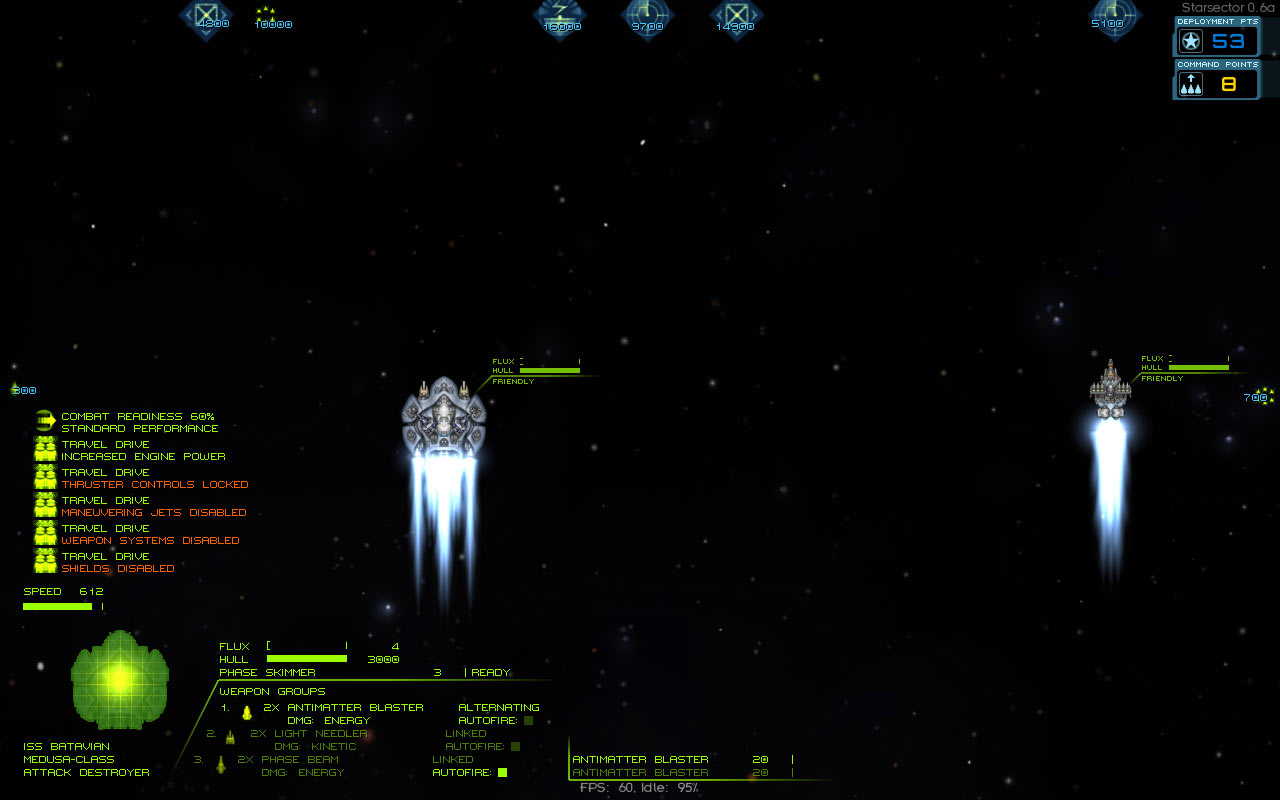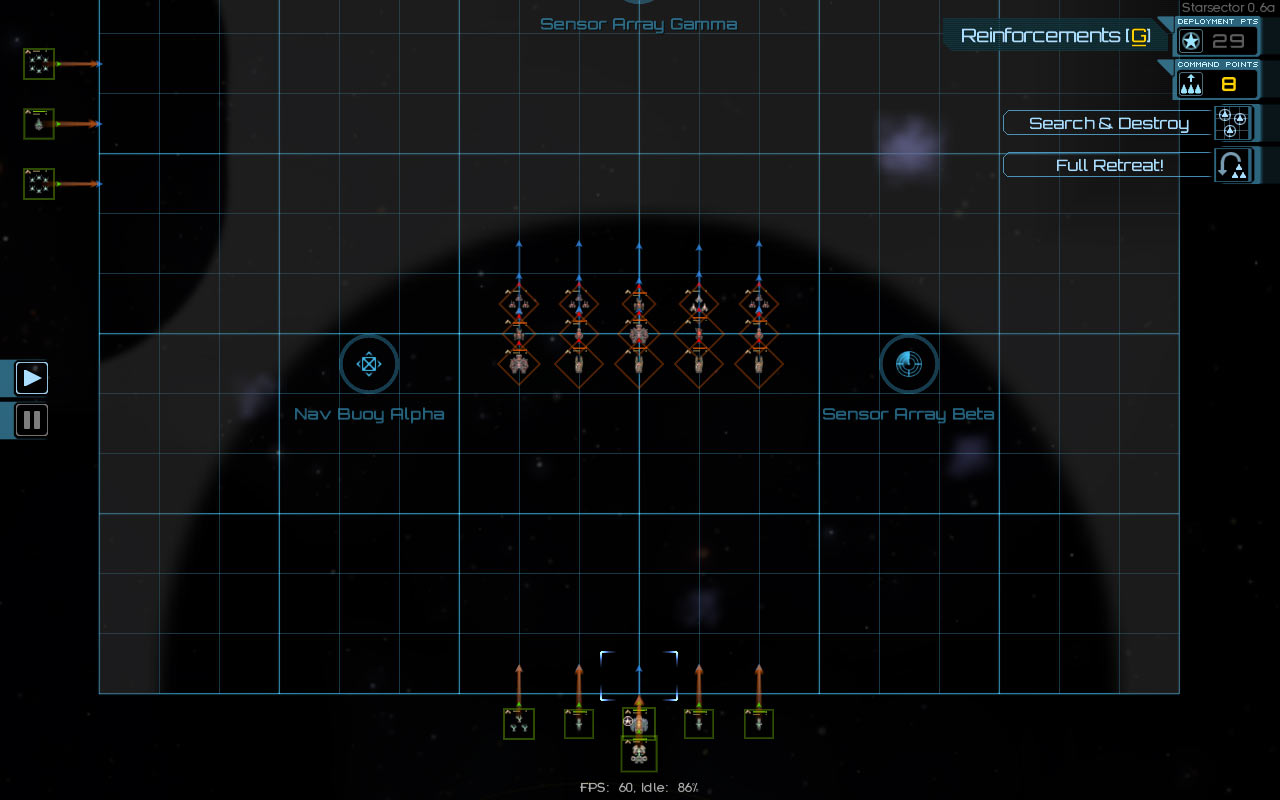Fleet Encounter Mechanics, Part 2
Part one is here. If you haven’t read it, it provides context for what I’m going to talk about here.
Travel Drive
Conceptually, ships use a different, much faster means of transportation for travel than they do for battle. Presumably, they either have to pop out of it every so often to navigate, or are forced to slow down by targeted nav system interference/debris fired across the projected trajectory/need to divert engine power to defensive systems due to the threat of enemy fire/<insert your favorite technobabble here>. Personally, I’m in favor of it being some kind of nav interference, whether it’s due to hypervelocity debris or jamming. The point is, a fleet can be forced to slow down and engage in battle.
On the flip side, a fleet disengaging from battle means that they’ve been able to re-engage their travel drives and put on speed. Maybe the nav computers finally calculated a safe trajectory. Maybe enough distance has been gained to eliminate the threat of enemy fire. The concept was always there, even if it wasn’t directly explored in the gameplay.
But now, there’s an opportunity to use it to improve the experience. With that in mind, the new mechanics:
- A ship or fighter wing being deployed into combat comes in with travel drive on, and it remains on for about 5-6 seconds – enough time to move around 3 grid squares in the command screen
- A retreating ship or fighter wing engages travel drive when it gets to within a couple grid squares from the border it’s heading for to make its getaway

A Medusa and a Wolf entering battle with Travel Drive (possibly pending cooler name) on.
This does a couple of things, all of them to do with reducing the impact of borders on gameplay. One, maps can be bigger without battles taking too long to heat up, because the extra space around the border is traversed very quickly using travel drive. This extra padding means objectives – which fighting often centers around – can be much farther away from borders. Two, retreating ships separate from pursuit far away from the border, almost entirely eliminating the “chase ship all the way to a border” situation.
Escape Scenario
When one fleet wants to run away but the other fleet doesn’t want to let them, what happens is a normal battle, but with modified rules.
First of all, regardless of whether it’s the player or the AI, the escaping side starts out fully deployed, a good ways up the map – 7 grid squares or so, less if the “harry” option was chosen by the attacker after a previous engagement (see previous blog post). The escaping side has to retreat at top border of the map, and the map itself is taller than the standard one.
Second, the pursuing fleet always deploys from the bottom of the map, but their frigates and fighter wings also have the ability to deploy from the left or right. This can be used to secure an important objective (such as a Nav Buoy; as you might imagine, speed matters here) or just to more quickly achieve contact with the retreating ships. The left/right deployment is far enough up the map that any ships being so deployed are slightly closer to the enemy than they would be if deployed from the bottom.
There are a few special cases here that need to be addressed.
What if the disengaging fleet is huge? Fleets beyond a certain fraction of the battle size can’t attempt to disengage – not maneuverable enough, let’s say – and have to fight. They can then attempt to disengage if they take enough losses.
What about ships that aren’t combat ready, what happens to those? They are also deployed, but can’t do anything other than try to retreat. They can’t fire their weapons, use their shields or ship system, etc.
What if the fleet is beyond the disengage size limit, but none of the ships are combat-ready? That’s very much an edge case, but the system still needs to handle it – let’s say it’s allowed to try to escape. It’ll likely get shot to pieces in the process, what with none of the ships being combat-capable, but at that point it’s not exactly drowning in options.
 Initial deployment in the Wolf Pack mission
Initial deployment in the Wolf Pack mission
All in all, we have something that works like you’d imagine a chase to work – the attacker trying to pick off the slower ships, while the escorts for the retreating force try to delay pursuit long enough for some of their ships to escape.
Boarding
Boarding is tricky because if it’s too easy, it can trivialize the rest of the game. If the player can get a ship at the cost of a few marines, then why would they use other, more expensive means, such as buying or manufacturing one? Right now, the odds of being able to board a ship are low, but that’s not enough because there’s no cost to rolling the dice over and over until they come up “board”. Presumably, the player can create a fleet that wins against some type of enemy without any casualties (hence “no cost”), and then they could use boarding as a means to grow their fleet. Lowering the odds just makes this a more time-consuming process.
Now, time itself is a cost, especially when it starts to matter in the campaign – i.e. not only do you need more ships in an abstract way, but you need them now, to do something specific before it’s too late. But, they’d still get a random trickle of “free” ships from whatever combat do engage in while going about their business. It’s also difficult to put a value on time, since it changes so much – from not being worth very much early on to being worth much more later.
(I’m going to completely ignore reloading and trying until one gets the boarding results they want. The game is balanced for iron mode, where that’s not an option – there’s nothing wrong with save scumming, but it’s not something you can balance for, either.)
Ultimately, though, it comes down to this: I don’t think getting “free” ships has the right feel. Things are looking grim for the denizens of the Sector; it’s a struggle just to get by, and one has to fight for everything they get. The mechanics spitting up a shiny new ship every so often is at odds with that. (Ok, fine, not so shiny, but easy enough to repair.)
Still, I’d like to keep boarding around. It’s a neat concept, and it’s also a safety net because it ensures more ships are attainable even if they can’t be bought; either due to lack of stock, hostilities with the faction that would sell them, or some such.
With that in mind, boarding should be a way to get new ships rather than a way to get more ships. Thus, there’ll be a very high cost to successful boarding. Over time, this cost should be at least on par with, or higher, than the cost to acquire this ship by other means.
New Boarding Mechanics
One disabled enemy ship may be randomly picked for boarding after combat. (Currently, fighters can’t be boarded. Need to reconsider some mechanics around fighters anyway; stay tuned.) Presumably, the surviving crew on that ship have got some systems working and might be able to get it underway unless the winner interferes. Having more disabled enemy ships to pick from increases the odds of one of them being boardable, but only one ship can be boarded per encounter.
Once that ship is picked, the winner has these options:
Organize a boarding task force
Select ships that will participate in the boarding action. The ships need to be combat-ready and will lose additional CR. The ship selection determines the maximum number of crew and marines that can be sent in a boarding party, but also exposes these ships to danger if the enemy ship self-destructs.
Order nearby ships to engage
Do not board, shoot the ship down instead. Requires some ready ships, but there’s no risk, though the enemy ship might get away. The AI always picks this option if it’s available. Note that this leaves the player a chance to escape with a single ship, even after a total defeat!
Let it go
Not much reason to choose this at the moment, as with the “Let them go” option from part one, but other options might not be available.
 About to try boarding a Venture. Wouldn’t want to be on that boarding party; the odds aren’t so good.
About to try boarding a Venture. Wouldn’t want to be on that boarding party; the odds aren’t so good.
If the player decides to board, they get to choose how many marines and crew to send, and what type of strategy to use. Before making this choice, or, indeed, before even making the decision to board, the player can see roughly how many lifesigns there are on the ship about to be boarded. They can’t see whether these are crew or marines, though, and marines are drastically better at repelling attacks.
Hard dock and attack ship-to-ship
The best combat effectiveness for the boarding party and the highest odds of a successful capture. However, the ships involved could suffer serious damage or be destroyed if the ship being boarded self-destructs. The damage is based on the flux capacity of the ship being boarded, so larger ships have better odds of surviving the self-destruct of a smaller ship.
Launch assault teams from a distance
Poor combat effectiveness results in much higher personnel losses, but there is no risk to the ships in case of a self-destruct. The enemy ship also has a chance to make a clean getaway before the assault teams can land.
There are four possible outcomes to a boarding action: the ship is captured, self-destructs, gets away, or is captured but sustains too much damage in the process (and goes back to the “disabled” state). I mentioned earlier that on average, boarding a ship should have a cost higher than its value. Adjusting the probabilities of the outcomes and the cost of marines is an easy way to control that.
The player also has ways to reduce the cost. Using ships with higher crew capacity (such as the Valkyrie troop transport) means less ships exposed to danger. Fitting them with hull and armor enhancing mods further reduces the risk.
Overall, boarding is a series of gambles that stretches out over multiple battles. The player can affect their odds and how much they wager. Sustained boarding attempts aren’t going to be something a small fleet does on a regular basis, though. It’s more the domain of larger fleets where losing a ship or two (or suffering heavy marine casualties) to get a new ship back in the long run is acceptable. Smaller fleets focused on boarding could be successful, too, but would be more susceptible to bad luck if they try for something out of their league – such as trying to board a cruiser with smaller ships, which is just asking to lose all of them to no gain.
Comment thread here.
Tags: boarding, escape, fleet encounter, travel drive










